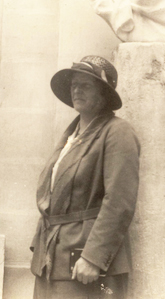Dorothea Bate
Dorothea Minola Alice Bate (born November 8, 1878 in Carmarthen , Wales , † January 13, 1951 in Westcliff-on-Sea , Essex ) was a British vertebrate paleontologist , zoologist and ornithologist . She was a pioneer in archeozoology and an expert on fossil mammals in the Mediterranean islands.
Life
Bate was the daughter of a police officer (superintendent), took an early interest in natural history and in 1898 received a post at the Natural History Museum in London in the birds department and in the preparation of fossils. At the time, the British Museum of Natural History did not employ women (which it did until 1928), but she impressed curator of birds Richard Bowdler Sharpe with her knowledge of bird taxonomy. During this work she acquired her further scientific knowledge over the years. In 1901 she succeeded in making the first publication (encouraged and supported by Henry Woodward ) about a site of Pleistocene mammals (in the Wye Valley , where her family moved in 1898 and where they explored limestone caves). Also in 1901 she visited Cyprus at her own expense and found fossils of a pygmy hippopotamus there . Soon after, she returned on a Royal Society grant and found a dwarf elephant ( Elephas cypriotis , now Palaeoloxodon cypriotes ), which she first described in 1903. In addition to fossils, she also collected birds, mammals, insects and other animals.
She subsequently visited a number of other islands in the Mediterranean, such as Crete in 1904 , where she found an extinct pygmy hippopotamus and pygmy elephant as well as the Cretan pygmy mammoth and came into contact with excavators such as Arthur Evans in Knossos and in particular Harriet Boyd Hawes and Edith Hayward Hall , Corsica , the Balearic Islands (three campaigns 1909 to 1911), where she described the extinct so-called cave goat Myotragus balearicus on Mallorca (1909), Sardinia and Malta and she did research in Africa, including Sudan . She mostly traveled alone, at most accompanied by local guides and helpers she had recruited herself. She was extremely stubborn and did not allow herself to be stopped by dangers in the mostly unpopulated or hardly populated, impassable areas. In her excavations - often in caves - she also used dynamite. From 1929 she worked with the archaeologist Dorothy Garrod , who excavated the caves in Carmel and the Zagros Mountains , where she worked on the fossil fauna. In the 1934 campaign, she was also at Carmel herself (they found remains of the Mesopotamian fallow deer , gazelles and pigs , among other things ). She later identified animal fossils for other archaeologists and anthropologists such as Louis Leakey . She was particularly interested in the reconstruction of past biotopes and the climate from fossil data in collaboration with archaeologists. For example, clues about the Carmel climate were derived from the relationship between the bones of fallow deer and gazelles.
From 1935 to 1937 she dug up fauna up to 1.8 million years old on a hill near Bethlehem (elephants, rhinos, giant tortoises and the horse Hipparion ).
From her observations of isolated faunas on islands, she identified a trend towards both dwarfism (in originally large animals such as elephants) and gigantism (in small animals).
During this entire time she became a curator for birds and Pleistocene mammals, but was only paid on the basis of the fossils and collectibles she prepared or she was financed through grants from the Royal Society, for example. She did not get an official permanent position until 1948. During the war years, the zoological collections of the museum were relocated to the countryside in Tring , in the former private museum of the 2nd Baron Rothschild . In 1948 she became the director of the Natural History Museum in Tring.
In 1940 she became a Fellow of the Geological Society and received their Wollaston Fund .
She was never married. A part of her private papers burned after her death, but a large part of her diaries and notes are in the British Museum of Natural History. During her lifetime she published around 80 reports and articles and produced around 100 unpublished reports on special collections.
Dedication names
Named after her are: Cervus dorothensis (Capasso Barbato 1992), Mus bateae (David Mayhew 1977) and Myotragus batei (Crusafont Pairo, Basilio Angel 1966).
literature
- Karolyn Shindler Discovering Dorothea: the Life of the Pioneering Fossil-Hunter Dorothea Bate , Harper Collins 2005
- Karolyn Shindler A knowledge unique: the life of the pioneering explorer and palaeontologist, Dorothea Bate (1878-1951) in CV Burek, B. Higgs (editor) The Role of Women in the History of Geology , Geological Society, London, Special Publications 281 , 2007, pp. 295-303
Web links
- Biography at the Natural History Museum
- David Bressan Dorothea Bate. The great lady of island paleontology
Individual evidence
- ↑ Karolyn Shindler Mystery of the Majorcan mouse-goat , The Telegraph, April 13, 2009
- ^ Bate, Garrod The Stone Age of Mount Carmel , 2 volumes, Clarendon Press 1937
| personal data | |
|---|---|
| SURNAME | Bate, Dorothea |
| ALTERNATIVE NAMES | Bate, Dorothea Minola Alice (full name) |
| BRIEF DESCRIPTION | British paleontologist and zoologist |
| DATE OF BIRTH | November 8, 1878 |
| PLACE OF BIRTH | Carmarthen , Wales |
| DATE OF DEATH | January 13, 1951 |
| Place of death | Westcliff-on-Sea , Essex |
